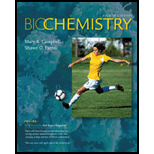
Concept explainers
RECALL Match the following statements about protein structure with the proper levels of organization. (i) Primary structure (ii) Secondary structure (iii) Tertiary structure (iv) Quaternary structure
(a) The three-dimensional arrangement of all atoms
(b) The order of amino acid residues in the polypeptide chain
(c) The interaction between subunits in proteins that consist of more than one polypeptide chain
(d) The hydrogen-bonded arrangement of the polypeptide backbone.
Interpretation:
The statements about protein structure are to be matched with the level of organization.
Concept Introduction:
The structure of protein is a three-dimensional arrangement of atoms in an amino acid-chain molecule.
There are four levels of organization in the protein structure, namely primary structure, secondary structure, tertiary structure and quaternary structure.
Answer to Problem 1RE
Solution:
a) Tertiary Structure.
b) Primary Structure
c) Quaternary Structure.
d) Secondary structure.
Explanation of Solution
Explanations:
The three-dimensional structure of protein is the tertiary structure. Tertiary structure consists of one polypeptide chain and one or more secondary protein structures.
The primary structure is a one-dimensional first step in defining the
A protein consists of multiple polypeptide chains called subunits which interact with each other through non-covalent bonds.
The secondary structure has repetitive interactions resulting from hydrogen bond formation between the amide and carbonyl group of the peptide backbone.
There are four levels of organization in proteins, namely primary, secondary, tertiary and quaternary, based on the arrangement of the atoms.
Want to see more full solutions like this?
Chapter 4 Solutions
Biochemistry
- REFLECT AND APPLY Comment on the energetics of protein folding in light of the information in this chapter.arrow_forwardREFLECT AND APPLY Glycine is a highly conserved amino acid residue in proteins (i.e., it is found in the same position in the primary structure of related proteins). Suggest a reason why this might occur.arrow_forwardREFLECT AND APPLY Compare the information in the sequence of monomers in a polysaccharide with that in the sequence of amino acid residues in a protein.arrow_forward
- REFLECT AND APPLY Suggest an explanation for the observation that when proteins are chemically modified so that specific side chains have a different chemical nature, these proteins cannot be denatured reversibly.arrow_forwardREFLECT AND APPLY Theoretically, a protein could assume a virtually infinite number of configurations and conformations. Suggest several features of proteins that drastically limit the actual number.arrow_forwardREFLECT AND APPLY You are in the process of determining the amino acid sequence of a protein and must reconcile contradictory results. In one trial, you determine a sequence with glycine as the N-terminal amino acid and asparagine as the C-terminal amino acid. In another trial, your results indicate phenylalanine as the N-terminal amino acid and alanine as the C-terminal amino acid. How do you reconcile this apparent contradiction?arrow_forward
- REFLECT AND APPLY Nucleic acids are polymers of just four different monomers in a linear arrangement. How many different sequences are available if one makes a polymer with only 40 monomers? How does this number compare with Avogadros number?arrow_forwardREFLECT AND APPLY List two classes of compounds derived from arachidonic acid. Suggest some reasons for the amount of biomedical research devoted to these compounds.arrow_forwardRECALL Is it possible to form cyclic peptides without bonds between side chains of the component amino acids?arrow_forward
- REFLECT AND APPLY Both RNA and DNA have negatively charged phosphate groups as part of their structure. Would you expect ions that bind to nucleic acids to be positively or negatively charged? Why?arrow_forwardRECALL What is the structure of ATCase?arrow_forwardREFLECT AND APPLY The fidelity of protein synthesis is assured twice during protein synthesis. How and when?arrow_forward
 BiochemistryBiochemistryISBN:9781305961135Author:Mary K. Campbell, Shawn O. Farrell, Owen M. McDougalPublisher:Cengage Learning
BiochemistryBiochemistryISBN:9781305961135Author:Mary K. Campbell, Shawn O. Farrell, Owen M. McDougalPublisher:Cengage Learning
